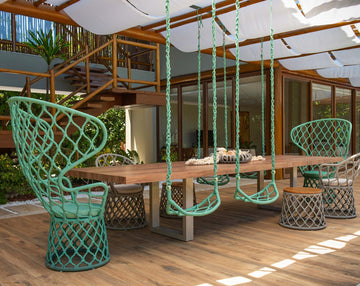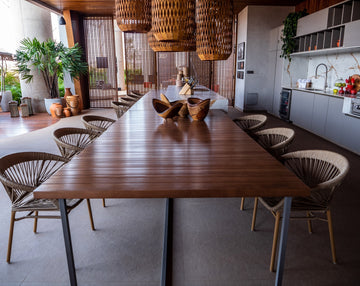The Poetry of Swings: Freedom and Contemplation Amid Nature
Sitting on a swing is a quiet lesson in breathing slowly again. There’s something timeless and almost primal about that gentle rhythm — a movement that invites stillness, a gaze that drifts among the leaves, time stretching and curving like a verse that only completes itself when the landscape replies.
This article explores how swings transform spaces — indoors and outdoors — while offering physical and emotional benefits, along with practical tips on choosing, positioning, and maintaining your piece of tranquility.
Why Are Swings So Fascinating?
The rhythmic motion of a swing stimulates the vestibular system, creating a calming effect that reduces stress, releases endorphins, and helps regulate sleep and mood.
Studies on sensory experience show that direct contact with nature — the wind, birdsong, and natural textures — amplifies this restorative power.
Beyond emotional wellness, swinging also promotes balance, coordination, and light posture activation — making it ideal not only for residential spaces but also for corporate environments seeking “active pause” moments for employees.
Where and How to Install a Swing

Think of the swing as a small stage for contemplation.
- Space: allow at least 3–4 feet (≈1–1.2 m) of clearance in front and behind the seat.
- Height: aim for around 43 cm (17 in) from the floor, adjusting for comfort.
- View: face it toward what you wish to admire — a garden, a sunset, or the horizon — ideally with partial shade for daytime use.
- Safety: use strong fixtures and ensure the supporting structure (beam, pergola, or healthy tree) can handle dynamic weight.
Materials: A Blend of Beauty and Durability
The choice of material defines both the lifespan and atmosphere of the swing.
- Aluminum and treated metals: lightweight, corrosion-resistant, and perfect for contemporary designs.
- Solid wood (like teak): natural warmth and lasting durability when well treated — ideal for textured, cozy spaces.
- Synthetic fibers and nautical ropes: weather-resistant and artisanal in appearance — Tidelli’s handwoven nautical rope brings this refined, handcrafted touch.
A common mistake: leaving wooden pieces in direct contact with soil or moisture. Elevate them slightly, seal properly, and store cushions in dry areas to prevent damage.
Styling Ideas for Different Spaces

- Residential verandas: pair a rope or cocoon swing with outdoor rugs and potted plants to create a cozy reading nook.
- Gardens: place near a tree or deck, adding soft lighting for nighttime serenity.
- Corporate lounges and hotel patios: swings invite short breaks and creative thinking.
- Cafés and coworking spaces: create photogenic, relaxing corners that encourage guests to linger.
Simple Maintenance
- Wipe metal frames with a damp cloth and check fixings regularly.
- Reapply sealants on wooden swings annually.
- Clean ropes and fibers with a soft brush and mild soap; store cushions during rainy seasons.
Tidelli: Where Design Meets Poetry

For those who seek design, resilience, and emotion, Tidelli offers a wide collection of swings, hammocks, and rocking chairs that gracefully bridge indoor and outdoor living.
Each piece combines contemporary aesthetics with durable materials, creating personal sanctuaries of peace and beauty.
Choosing Tidelli is choosing furniture that lasts — and transforms the simple act of swinging into a daily poem of light, air, and contemplation.
Discover all Tidelli collections: click here.









